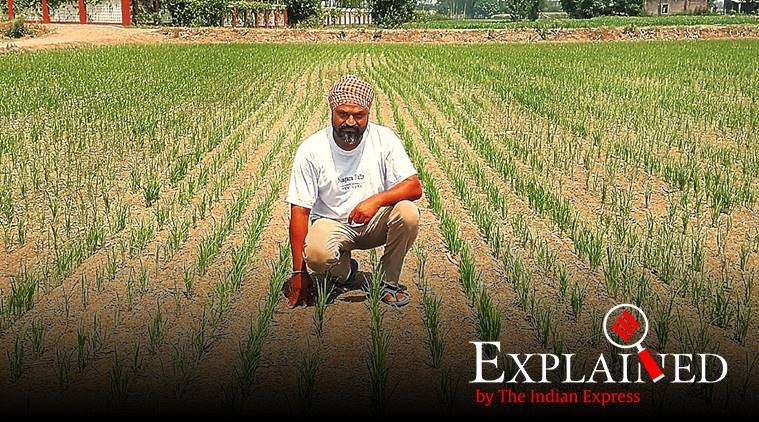Explained: Labour short, can direct seeding be alternative to paddy transplanting?

The two granary states of Punjab and Haryana could face a shortage of an estimated 10 lakh labourers, mainly seasonal migrants from Bihar and Uttar Pradesh, to undertake transplantation of paddy in the upcoming kharif season. With lockdown relaxations not extending to trains to ferry these labourers who usually arrive by early June, farmers are now being encouraged to adopt ‘direct seeding of rice’ (DSR) in place of conventional transplanting.
How is DSR different from normal transplanting of paddy?
In transplanting, farmers prepare nurseries where the paddy seeds are first sown and raised into young plants. These seedlings are then uprooted and replanted 25-35 days later in the main field. The nursery seed bed is 5-10% of the area to be transplanted.
In DSR, there is no nursery preparation or transplantation. The seeds are instead directly drilled into the field by a tractor-powered machine. The Punjab Agricultural University (PAU) in Ludhiana has developed a ‘Lucky Seed Drill’ that can both sow seeds and simultaneously spray herbicides to control weeds. This machine is different from the more popular ‘Happy Seeder’, used to directly sow wheat on combine-harvested paddy fields containing leftover stubble and loose straw.
But why spray herbicides along with sowing seeds?
Paddy seedlings are transplanted on fields that are “puddled” or tilled in standing water using tractor-drawn disc harrows. For the first three weeks or so after transplanting, the plants have to be irrigated almost daily (if there are no rains) to maintain a water depth of 4-5 cm. Farmers continue irrigating every 2-3 days even for the next 4-5 weeks, when the crop is in the tillering (stem development) stage. The underlying principle here is simple: Paddy growth is compromised by weeds that compete for nutrition, sunlight and water. Water prevents growth of weeds by denying them oxygen in the submerged stage, whereas the soft ‘aerenchyma tissues’ in paddy plants allow air to penetrate through their roots. Water, thus, acts as a herbicide for paddy. The threat from weeds recedes once tillering is over; so does the need to flood the fields.
In DSR, water is replaced by real chemical herbicides. Farmers have to only level their land and give one pre-sowing irrigation or rauni. Once the field has good soil moisture, they need to do two rounds of ploughing and planking (smoothening of soil surface), which is followed by sowing of the seeds and spraying of herbicides.
What are these herbicides?
There are two kinds. The first is called pre-emergent, i.e. applied before germination. In this case, the pre-emergent herbicide used is Pendimethalin. The Lucky Seed Drill that sows paddy can also spray the chemical, which costs Rs 450-500 at one litre per acre. Alternatively, farmers can use an ordinary seed drill and apply the herbicide immediately after sowing. The second set of herbicides is post-emergent, sprayed 20-25 days after sowing, depending upon the type of weeds appearing. They include Bispyribac-sodium (Rs 600-700 at 100 ml/acre) and Fenoxaprop-p-ethyl (Rs 700-800 at 400 ml/acre).
What is the main advantage with DSR?
The most obvious one is water savings. According to PAU’s director of research Navtej Singh Bains and principal agronomist Makhan Singh Bhullar, the first irrigation (apart from the pre-sowing rauni) under DSR is necessary only 21 days after sowing. This is unlike in transplanted paddy, where watering has to be done practically daily to ensure submerged/flooded conditions in the first three weeks. The second savings, relevant in the present context, is that of labour. About three labourers are required to transplant one acre of paddy in a single day. Pritam Singh Hanjra, a farmer from Urlana Khurd village in Haryana’s Panipat district, says that the transplanting labour costs last year were around Rs 2,400 per acre, “which may double this time”. As against this, the cost of herbicides under DSR will not exceed Rs 2,000 per acre.
Are there drawbacks?
The main issue is availability of the herbicides. Pendimethalin is sold by companies such as BASF (under ‘Stomp’ brand) and PI Industries (‘Bunker’). Bispyribac-sodium and Fenoxaprop-p-ethyl are marketed, among others, by PI Industries and Bayer under ‘Nominee Gold’ and ‘Ricestar’ brands, respectively. “If every farmer does DSR, will the demand for these chemicals be met? The seed requirement for DSR is also higher, at 8-10 kg/acre, compared to 4-5 kg in transplanting. Further, laser land levelling, which costs Rs 1,000/acre, is compulsory in DSR. This is not so in transplanting,” Hanjra said.
Surjit Singh, a 60-acre farmer from Gakhlan village in Punjab’s Jalandhar district, tried out DSR for the first time on two acres in 2017. This he increased to 6 acres and 10 acres in the next two years. “I am planning to do 15 acres in the coming season. The yields are as good as from normal transplanting, but you need to sow by the first fortnight of June. The plants have to come out properly before the monsoon rains arrive. There is no such problem in transplanting, where the saplings have already been raised in the nursery,” explained Singh, whose spring maize crop on the balance 45 acres will be harvested only towards June-end.
How much area is likely to come under direct seeding of rice?
The adoption of any new technology, be it Happy Seeder or Lucky Seed Drill, is ultimately dependent upon farmers feeling the need. The maximum area covered by DSR in Punjab was roughly 1.60 lakh hectares (lh) in 2015 — which dropped to 19,600 hectares, 1,100 hectares, 5,000 hectares and 23,300 hectares in the subsequent years. Sutantar Kumar Airi, director of Punjab’s Agriculture Department, expects it to rise to 2-2.5 lh this time on the back of labour shortages. Even that would be hardly a tenth of the state’s total 29-30 lh paddy area.
Source : indianexpress